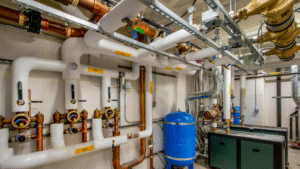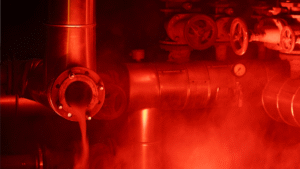The global demand for clean and reliable water has never been greater. Across industries and municipalities, the latest water treatment trends reveal a strong shift toward efficiency, sustainability, and technological innovation. Driven by rapid urbanization, industrial growth, and a rising population, today’s wastewater treatment and industrial effluent treatment systems are evolving to meet increasing demand while protecting the environment.
Water scarcity continues to challenge both developed and emerging regions, making sustainable water management a critical priority. Facilities are adopting advanced approaches that minimize chemical waste, reduce energy use, and enhance overall water quality. As governments and industries collaborate to strengthen infrastructure and safeguard public health, the integration of chemistry, digital tools, and renewable processes defines a new era for water and wastewater management.
Within this context, chemical blending has emerged as a vital factor in enabling the next generation of treatment efficiency and innovation—setting the foundation for how modern facilities respond to changing water treatment trends.
Understanding Chemical Blending in Modern Treatment Processes
Chemical blending is one of the most crucial yet often overlooked components of modern water treatment and wastewater treatment system operations. It involves the precise formulation of multiple chemical agents—such as coagulants, scale inhibitors, corrosion control agents, and oxidizers—to optimize treatment processes and maintain consistent water quality across diverse conditions.
In today’s facilities, chemical blends play a pivotal role in ensuring that advanced treatment technologies such as reverse osmosis and membrane filtration perform efficiently. Proper chemical balance helps reduce scaling and fouling, extend membrane lifespan, and maintain stable process parameters. These functions are vital for industries seeking greater operational efficiency and compliance with environmental standards.
As treatment systems evolve, the integration of tailored chemical solutions enables facilities to adapt to changing feedwater characteristics, local regulations, and production requirements. Through strategic formulation and testing, chemical blending transforms from a background process into a performance-driven practice that underpins modern advanced treatment systems. It is the foundation on which reliable, adaptable, and sustainable water treatment is built.
The Chemistry Driving Emerging Treatment Technologies
Chemical science lies at the center of today’s most transformative water treatment trends. Across wastewater treatment facilities and industrial effluent treatment systems, chemistry governs how pollutants are removed, membranes are protected, and resources are recovered. The latest emerging technologies illustrate how precise chemical blending drives progress toward cleaner, more sustainable water management.
1. Advanced Oxidation Processes (AOPs)
Among the most impactful innovations, advanced oxidation processes (AOPs) use reactive oxygen species to break down complex and persistent pollutants. These reactions neutralize organic contaminants, heavy metals, and endocrine disrupting chemicals, helping meet stricter discharge regulations. The formulation of oxidants, catalysts, and stabilizers determines treatment speed and safety, making chemical blending a critical enabler of effective AOP systems.
AOP chemistry is also being integrated with renewable energy inputs, such as solar-driven UV and electrochemical cells, which enhance oxidation efficiency while lowering carbon intensity. This synergy strengthens sustainable practices in modern treatment operations.
2. Membrane Filtration and Desalination Chemistry
Membrane filtration and desalination technologies rely on carefully balanced chemical blends to ensure consistent water flow and contaminant removal. Anti-scalants, dispersants, and pH conditioners maintain optimal system performance and extend membrane life in advanced treatment systems such as reverse osmosis and nanofiltration.
These chemical formulations not only enhance pollutant removal but also improve process stability, especially under fluctuating feedwater conditions. The outcome is lower downtime, improved throughput, and reduced operational costs across industrial applications.
3. Carbon-Based and Bioactive Treatment Chemistry
Carbon-based materials, including activated carbon and biochar, remain essential for adsorbing organic compounds and trace pollutants. When paired with optimized chemical blends, these systems achieve higher selectivity and resource recovery efficiency.
Emerging research also highlights bioactive chemical solutions that complement advanced treatment technologies, supporting the degradation of residual contaminants and reducing sludge generation. Such innovations demonstrate how chemistry underpins both mechanical and biological advancements in water and wastewater purification.
The Industrial Impact: Efficiency, Cost, and Sustainability
In the industrial sector, where operational uptime and compliance are paramount, chemical blending has become a vital contributor to efficiency, cost control, and environmental stewardship. Within modern water treatment trends, chemical formulations are now tailored to specific industries, enabling greater precision in scaling prevention, corrosion control, and microbial management.
For large-scale industrial facilities, optimizing chemistry directly translates into reduced energy consumption, longer equipment life, and lower maintenance costs. Custom chemical programs stabilize process variables in boilers, cooling towers, and wastewater treatment plants, minimizing downtime and supporting reliable output. These enhancements also enable greater wastewater reuse, providing access to consistently treated water that meets discharge and recycling standards.
Globally, industries are responding to stringent environmental regulations set by agencies such as the Environmental Protection Agency and international equivalents. These policies are driving investments in advanced treatment technologies and encouraging collaboration between chemical suppliers, engineers, and facility managers. In regions such as the Asia Pacific and the Middle East, expanding urban centers and strong government initiatives are fueling infrastructure investments that prioritize cleaner, more resilient treatment systems.
Digital Water Solutions and Decentralized Systems
Digital transformation is reshaping how water treatment trends are implemented in the field. By combining data-driven tools with precise chemical blending, operators can now predict changes in water quality, automate adjustments, and ensure consistent compliance across distributed sites. The growing adoption of digital water solutions and decentralized systems represents a major shift toward flexibility and efficiency in the global water sector.
Digital Water Management and Monitoring
Advancements in digital water management allow facilities to continuously assess and control chemical dosing through smart sensors and cloud-based analytics. Digital monitoring platforms track pH, flow rates, and turbidity in real time, alerting technicians before issues arise. This approach minimizes equipment failures, reduces downtime, and extends the lifespan of assets across wastewater treatment plants and industrial systems.
By aligning chemistry with data insights, digital tools enhance reliability and optimize reagent usage—supporting both cost savings and environmental responsibility.
Decentralized and Localized Treatment Systems
The rise of decentralized systems and localized treatment units is redefining water management in remote or rapidly growing regions. Compact and modular by design, these treatment facilities can be deployed near points of use, minimizing transport losses and infrastructure costs.
When paired with smart chemical blending and automation, decentralized operations offer efficient solutions for wastewater treatment and water reuse—providing flexibility, scalability, and resilience in an era of unpredictable water challenges.
ETI’s Role in Supporting Chemical Blending for Industrial Water Treatment
In the evolving landscape of water treatment trends, ETI stands at the forefront of chemistry-driven innovation. With nearly four decades of experience, the company specializes in custom chemical blending designed to meet the precise challenges of industrial water treatment facilities across Pennsylvania and Ohio. ETI’s approach combines technical expertise, ISO-certified quality management, and practical field support to deliver measurable results in performance and reliability.
Through its Custom Blending and Formulations Excellence program, ETI engineers proprietary formulations that enhance corrosion protection, improve system efficiency, and simplify complex treatment regimens. Each blend is purpose-built to improve system stability, reduce operational costs, and promote sustainable practices across diverse treatment technologies.
Complementing this scientific foundation, ETI’s Old-School Field Support ensures that every formulation performs optimally in real-world applications. The company’s hands-on approach means specialists work directly with clients to test, adjust, and maintain systems—bridging laboratory precision with in-field experience.
Whether optimizing wastewater management, industrial effluent treatment, or closed-loop cooling systems, ETI remains a trusted partner committed to helping customers achieve long-term operational excellence through smarter chemistry.
Chemistry as the Cornerstone of Future Water Management
As industries continue to evolve, chemical blending remains a critical aspect of advancing modern water treatment trends. It bridges scientific innovation with operational reliability, ensuring that advanced technologies deliver consistent results across every process—from desalination to wastewater treatment.
ETI’s long-standing commitment to precision chemistry, sustainable formulation, and hands-on technical support ensures that every client benefits from dependable solutions tailored to their systems.
To learn how ETI’s custom blending expertise can strengthen your water treatment facilities and improve long-term performance, contact ETI’s technical team today and discover the difference chemistry can make for your operation.
Frequently Asked Questions (FAQs)
What are the main treatment technologies used in wastewater treatment plants today?
Modern wastewater treatment facilities use a combination of advanced treatment systems, including membrane filtration, biological processing, and chemical oxidation, to meet strict water quality standards.
How do decentralized water infrastructure systems support public health and flood prevention?
Decentralized systems treat water close to its source, improving public health by preventing contamination and reducing overflow risks. Managing flows locally also helps mitigate conditions that can contribute to flooding.
Why is sustainable water management important for industrial expansion?
As industries grow, efficient wastewater management and sustainable water practices ensure long-term supply stability, regulatory compliance, and lower operating costs.
How does chemical blending contribute to water reuse?
Properly formulated blends enhance treatment reactions, enabling consistent wastewater reuse and the production of safe treated water for industrial or environmental applications.





